
PHOTO COURTESY KURT UETZ
The Sultana in its new home behind the Woods Hole Historical Museum awaiting a three to five year project to complete the historic half-model of a 1760 schooner.
WOODS HOLE – Passersby might not notice the schooner tucked in behind the boat shop at the Woods Hole Historical Museum. It is just a hull, after all, with paint that is faded and chipped.
But they might comment on the odd bulbous shape of the hull—reminiscent of the Mayflower— and if they found out it was handmade they might take a moment to wonder at the time it took to steam and hand bend each of those oak planks.
Named the Sultana, it is a half-scale model of a 18th century boat, a Marblehead schooner—a massive project begun by one Fred Littleton of Chilmark, Martha’s Vineyard, who was 75 years old when he began the project.
Once they found that out, they might take a moment to wonder at the sheer audacity and the skill it took to complete the hull at all.
They might even chuckle at the series of events—the synchronicity—that a boat begun in a shed in Chilmark has ended up via a home in Centerville to a boat shop in Woods Hole, a place where a group of mostly retired fellows—including one who is 86—with a passion for history and boat building, will see it through to completion.
This is the story of a schooner, but more than that, it is the story of a man who built the hull of a schooner and the men who, in the coming years, painstakingly, skillfully and with a tip of the hat to the man who began it 16 years ago, will finish it.
![]() The Beginning: Ordering the Wood
The Beginning: Ordering the Wood
The beginning of the story might be an old receipt written on faded stationary. In the top left of the page is printed, “Fred’s Boat Shop.” Under that heading it states, “Traditional Wooden Boats.” There is a simple drawing of a sailboat and underneath that it says, “Middle Road, Chilmark MA.” On the top right side of the stationery is a drawing of two-masted schooner.
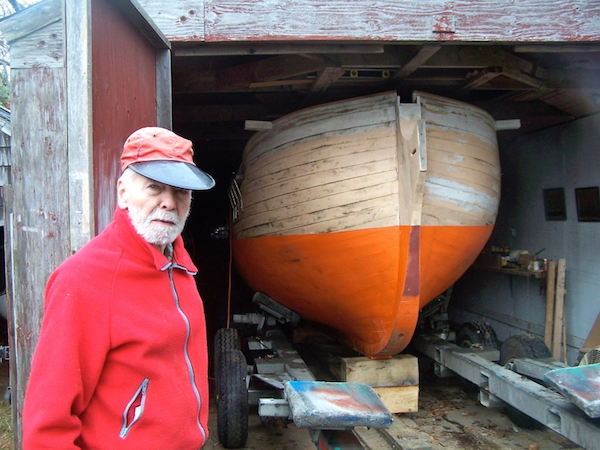
PHOTO COURTESY CLEM LITTLETON
Fred Littleton, a Philadelphia lawyer who retired to Martha’s Vineyard and served as the harbormaster in Menemsha for 10 years, built the hull of the Sultana in his boat shop at his home in Chilmark on Martha’s Vineyard. His son, Clem Littleton, took this photo of the day when the Sultana emerged from the shed.
On the page is a handwritten order for the wood to build a boat. “Mark Villa, I need vertical grain white pine as clear as practicable. 25 pieces, 10 feet long to finish 1 inch thick and 2 1/2 inches wide. Thanks, Fred Littleton.”
The note is dated June 29, 1999. This is the start: ordering the wood to build the boat, a half-scale model of a historic schooner, the kind of boat that was built for speed and used by the British for patrolling the waters around Cape Cod prior to the Revolutionary War.
Now to skip to the end of the story.
The end begins with an ad on Craigslist in October 2014. The ad listed a hull of a boat, a half-scale model of a historic schooner, located on a Centerville property in the town of Barnstable on Cape Cod.
The ad was for the Sultana.
![]() Answering the Ad on Craigslist
Answering the Ad on Craigslist
John Bruce, a retired Woods Hole scientist, spotted the Craigslist ad. Bruce is a friend of Alan Lunn, who is one of the guys who work on old boats in a Saturday group at the Woods Hole Historical Museum’s boat restoration program.
The boat shop members, some retired, some not, all with a passion for repairing boats, gather on Saturdays to work on boats that have been donated to the museum. When the boats are sold, the proceeds benefit the museum.
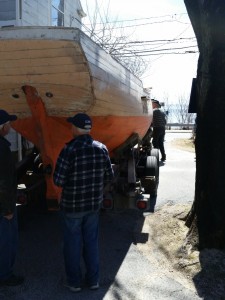
PHOTO COURTESY KURT UETZ
Some of the boat shop guys at the Woods Hole Historical Museum survey the Sultana as it arrives on the museum property earlier this spring.
Among the boat shop guys are two boat builders, Al Lunn and Bob Spates, who have been building and restoring boats for 60 years or more each, and one, Bob Leary, who has been building boats for 20 years. The rest, explained one of the newer boat shop volunteers, Kurt Uetz, have various degrees of experience in boat building and wood working.
The Woods Hole Museum sits next to the Woods Hole Library in an 1804 building across from the road that leads to the Steamship Authority terminal in the village of Woods Hole. The Steamship Authority boats take passengers over to the island of Martha’s Vineyard and that, as it turns out, is where Sultana began her life.
But the Woods Hole boat shop builders following up on the Craigslist ad didn’t know that at the time.
All they knew is the ad listed a historic replica hull—a half-finished boat. Turns out the owner was willing to donate it to the right party.
John Bruce, along with Lunn, Bob Leary and Kurt Uetz, all boatbuilders with the Woods Hole Museum group, went to take a look at the boat and they were impressed.
Uetz said, “It really was ‘Wow.’ And as boatbuilders, ‘look at all the work.’ All that work and thousands of hours and donated to the museum.”
Lunn said, “I thought it was the best deal to come down the pike in a long time. It’s well-built, certainly an interesting vessel and would be fun to work on.”
“Everyone is in awe of the work [the boat builder] did by hand to do this,” Uetz said.
Uetz described “a three-dimensional curve where the rudder will be and continues to a wineglass stern; it’s all white cedar planking. He had to steam and bend each one of those boards. I couldn’t estimate how many thousands of hours he put in this to build the hull. It’s a beaut.”
Lunn said, “It must have been a difficult thing to plank up. The fellow that built it was obviously an excellent shipwright.”
Lunn started building boats in high school in 1946 and had his own shop, Lunn’s Boat Shop, on Great Harbor in Woods Hole for decades. He has built a lot of boats and has built models of historic boats, but never a historic half-scale replica of this era.
“I’ve always been curious about those old vessels and how they were built and how they perform,” Lunn said.
Lunn, who is 86 years old, took note of the fact that the builder started the project when he was about 75 years old. “A guy taking on a project like that so late in life, maybe he thought he was another Joshua Slocum,” he said, referring to the 19th century explorer who sailed around the world.
The boat shop guys decided to propose that the museum take on the Sultana as a project.
![]() A Project for the ‘Boat Shop Guys’
A Project for the ‘Boat Shop Guys’
Jennifer Gaines, the Woods Hole Historical Museum executive director and curator, said she was keen on the idea of the museum acquiring the boat from the start. “I guess just because it is such an old historic replica. We haven’t done any old historic boats, [matching this one] in its historicity and its scale.”
She said that the museum focuses on boats in its boat shop and also in a separate Boat Barn that houses a small boat museum, because of the importance of boats to the history of the region.
“We consider boats to be a critical and very important aspect of our heritage. We thought [the trade of boat building] was dying off, so we established a boat restoration program to continue to teach boat restoration techniques to a new generation,” Gaines said.
She said she knew the boat shop guys were keen to take the project on.
Uetz knew right away that this would be a special project for the group. “This is bigger than anything we’ve done. It’s a historic design from the late 1700s. The hull is already built. We’re going to finish the cabin, the interior, all the rigging. It’s going to be at least a two-masted schooner,” he said.
Another big part of the project, Uetz said, would be installing an engine with a shaft and a propeller. “It’s not difficult marine engineering, but it’s a first for the museum boat shop,” he said.
![]() Museum Acquires Boat—But Where to Put It?
Museum Acquires Boat—But Where to Put It?
Uetz, who is on the museum’s steering committee, alerted the committee to the availability of the boat and the possibility of the museum acquiring the boat, restoring it and displaying it. There was discussion of what the completion of the boat would cost—$7,000 to $12,000 to rebuild it, perhaps $18,000 in total to finish it, Uetz said. As to how long it would take to rig the boat, Uetz estimated two to three years or “if things go bad, five to seven years.” He said, “There are a lot of unknowns here.”
Steering committee members talked about what the museum’s longterm strategy would be, whether it would be a static display or put in the water.
Lunn said the boat would fit in well with the museum’s boat building program, where they teach ship building, “particularly making spars and how to hew a mast from a tree like a shipyard.”
He explained that Marblehead schooners did use topmasts and would need a bowsprit.
“Woods Hole hasn’t seen anything like this since they built the whaling ships,” Lunn said.
Uetz explained to the committee that the Sultana is a model of a ship designed in 1750. The boats were used throughout the coast for cargo and shipping. “Very likely they had these operating out of Woods Hole in the 1800s,” he said.
Uetz added, “It’s really a head-turner.”

PHOTO COURTESY KURT UETZ
Finishing the Sultana, a half-model of an 18th century schooner, is the next project for the Boat Shop at the Woods Hole Historical Museum.
Arlene Lowenstein, chairman of the Woods Hole Museum steering committee, agreed the historic boat, its restoration and display was in line with the museum’s mission. “It fits in with our collection and display of items of historic value and also with our dedication to preserving and teaching the historic art of boatbuilding.”
Gaines said that she believed acquiring the boat met the museum’s educational mission too. “Part of what we’re doing is trying to preserve the heritage of boat building, old and new. This certainly fits into that.”
As to the future of the Sultana, there was discussion among steering committee members of getting a licensed captain to take people out for sails in the boat once it is finished or of outfitting it as a pirate vessel—Lunn, oddly enough, has a cannon that is the right scale—or it could be a tourist attraction that remains on the lawn of the museum.
And there was discussion of what would be needed to accomplish the work.
The boat shop would need rigging to build the mast and spars and rig lines, perhaps a plastic shelter to work in all weather, Uetz said.
Then there were logistical concerns.
There was worry about the boat being too big to make the turn into the narrow museum driveway and whether it could get by the large trees at the front of the museum property.
The steering committee voted approval and that began approximately five months of paperwork—many lawyers were involved—to put together a longterm lease. The problem was that there was not quite enough space on the museum property for the boat. The adjacent landowner, the Woods Hole Oceanographic Institution, agreed to lease a sliver of its land for the boat but lawyers were needed to draw up the long-term lease.
There were surveys and insurance and liability waivers that needed to be drawn up.
Uetz said the delay was frustrating for the boat shop members. “We were chomping at the bit for six months. He credited museum executive director Jennifer Gaines with getting the lease deal done with WHOI. “It took all winter but her perseverance really got us through and it was completed properly,” he said.
When it was looking like the permissions would be too hard to achieve, there was talk of placing the boat in the museum’s front yard, a sort of sign for the museum’s interest in historic boats.
One of the shop members is a retired arborist and he could help trim trees to allow the boat—27 feet long and 9 feet wide—to fit, a snug fit but a fit nonetheless, in front of the museum.
“A little scrunched,” is how Gaines saw the fit in front of the museum. The decision was made to keep with the plan to move the boat to the rear of the lot using the sliver of land leased from WHOI.
The Sweeneys, the owners of the property where the boat was in Centerville, had wanted it removed before it got snowed in. But as January turned into February and the entire Cape was covered with feet of snow, the project to remove the boat would have to wait for the spring.
Gaines credited the Sweeneys with extreme patience in waiting for all the paperwork and logistics to be completed before the boat could be moved.
One of the boat guys, Al Lunn, had already begun researching materials.
The boat will need two masts and Lunn said he had been scouting around at Falmouth’s town forest for an eight-foot circumference tree to do the job. “There are beautiful spruce trees that would make a great mast.” He got to talking with the guys at the Beetle Cat Company in Wareham and it turns out their company built a large catboat and got a mast from the town forest.
Lunn said the forest was planted 200 years ago with trees that were chosen because they would make for perfect masts for sailing ships.
“Those trees were planted specifically for use on vessel masts from the era,” Lunn said.
Uetz also was keen on getting to work on the boat. He marveled at the work of the original builder, how he built the oak hull and made the mahogany teak decks. He bent the oak by steaming the inch-and-a-half planks and formed the wineglass-shaped hull.
“He did a lot of hard work,” Uetz said.
In early April, the lease was finally completed between WHOI and the museum allowing the Sultana to come onto the property.
With the paperwork complete and the Cape’s snow melted, the move happened swiftly on Saturday, April 11. John Peck of Peck’s Boats moved the boat from Centerville to Woods Hole.
Uetz said Peck was impressed with the Sultana. “He’s seen a lot of boats but he hadn’t seen many like this,” Uetz said.
Peck helped the boat guys to stabilize the Sultana on stands behind the museum.
“We took all the advice we could get,” Uetz said.
Once the Sultana was in place at the museum, the boat shop guys could begin work on the boat. But none of them knew exactly how it ended up on Centerville until they met Clem Littleton, the son of Fred Littleton who conceived of and built the hull of the Sultana.
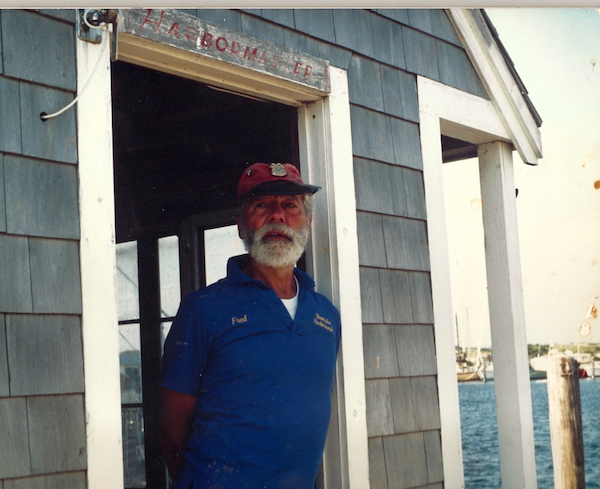
PHOTO COURTESY CLEM LITTLETON
This photo of Fred Littleton when he was harbormaster in Menemsha on Martha’s Vineyard, was taken by the famous photographer, Albert Eisenstaedt, who vacationed in Menemsha for more than 50 years. Eisenstaedt took many photos of Littleton and gave this one to the Littleton family.
Clem Littleton also saw the ad for the Sultana on Craigslist. When he called the Centerville couple who placed the ad and found out the boat his father built was going to be finished at the Woods Hole Historical Museum, he was delighted.
Littleton explained how the boat got from a barn in Chilmark on Martha’s Vineyard to Centerville. Mark Wilkins, a maritime historian and former curator the Cape Cod Maritime Museum in Hyannis, had heard about the Sultana and had hoped to get it into the Hyannis museum. He got it to his property in Centerville, but before he was able to get it to the museum, he ended up leaving his post at the museum and moving off-Cape. The boat was left in the yard in Centerville for the future homeowners. This was the Sweeneys. Along with the boat was a letter of intent to donate the boat to a museum. There were stands and 10 rough-cut oak planks the builder made to be used to finish the boat.
The Sweeneys wanted the Sultana removed from the property but they wanted it to go to a good home and they wanted to donate it.
![]() The First Part: The Boatbuilder
The First Part: The Boatbuilder
Fred Littleton, who constructed the hull of the Sultana, died in 2010 at the age of 85. Clem Littleton called his father “a boatbuilder extraordinaire and a sailor extraordinaire.” He had built other boats. His biggest project before Sultana was the Morrissey Jr., a 16-foot model of the 1894 schooner Ernestina-Morrissey. As a boatbuilder, his attention to detail was impressive. He used five-pound lead pieces for ballast, melting the cast iron into rectangular form to stow in the bow.
Clem Littleton is, at 58 years old, the youngest of Fred Littleton’s five children. He explained how his father came to build the Sultana.
Fred Littleton was, as his son put it, “a Philadelphia lawyer,” who had vacationed on Martha’s Vineyard since he was a young boy. He met his future wife, Elinor, at age 12 on the island at West Chop, when the two were staying with their families on vacation. They got married in 1946.
Clem Littleton described his father as “very outgoing” with “a crazy sense of humor, a practical joker.”
Fred Littleton had a passion for boats and sailing from a young age.
“Dad was quite a mariner,” Clem said. “It was nothing for him to row out to see ships in Vineyard Sound.”

PHOTOS COURTESY CLEM LITTLETON
Fred Littleton’s first boat building project was a 12.5-foot Brig. He built it in his home in Wayne, Pennsylvania in the 1970s. He sailed her in Quitsa Pond on Martha’s Vineyard for a few years.
As a boy, Littleton got to know the Martha’s Vineyard character, Zeb Tilton, a celebrated captain of the schooner, the Alice S. Wentworth.
At age 15 in 1940, Fred Littleton went to sea with Captain Bob Bartlett, the famed arctic explorer who captained the Ernestina-Morrissey and the teenaged Fred Littleton took videos of the experience that are now kept at Mystic Seaport Museum.
According to Clem Littleton, that early sailing experience “clinched it for him,” his love of boats and the sea.
“He was the most confident sailor I’ve ever met in my life,” Clem Littleton said of his father.
Years later, Fred Littleton built a 16-foot model of the Ernestina-Morrissey that he used to sail around the Vineyard.
In the early 1960s, Clem Littleton’s grandmother decided to build a house in Chilmark for the family’s Vineyard vacations.
Clem’s parents eventually retired to that house, moving from Philadelphia to Chilmark in 1985. Fred Littleton was 60 years old.
But retirement for Fred Littleton was not a laid back affair. He kept busy, volunteering for Meals on Wheels and serving as the chairman of the Chilmark Zoning Board of Appeals. He counted votes at Town Meeting and served as the Chilmark shellfish constable.
“He was into a lot of volunteer work,” Clem said.
Fred Littleton served as the harbormaster in Menemsha from 1985 to 1995, running the harbor from a 20-foot sloop.
Clem recalled one episode that summed up his father. When Fred Littleton moved to the Vineyard in the 1980s, it was very evident that the fishing industry was dying.
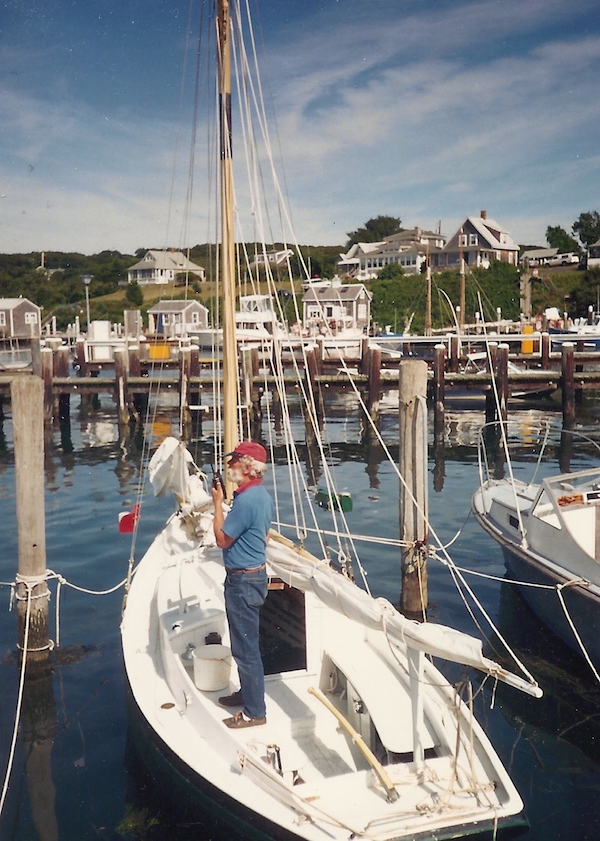
PHOTO COURTESY CLEM LITTLETON
Fred Littleton, who built the hull of the Sultana, served as the harbormaster in Menemsha on Martha’s Vineyard for 10 years. His son, Clem Littleton, took this photo of his father on his 20-foot sloop, Chaika, on a slip on the west side of Menemsha Harbor. He is on the radio running the harbor as part of his duties as harbormaster.
“The fishing fleet at Menemsha probably dropped 50 percent in three years. He’s keeping the peace between the well-to-do people with very fancy boats and on the other side of the harbor, the people working tooth and nail to make a living. He had a party for the fishermen at the end of the summer, brought them a half keg of beer. They loved him,” Clem Littleton said.
Fred Littleton built a shed in his yard to serve as a boat shop. He called it “the barn.”
That’s where he built a 14-foot skiff on the island to use as the harbormaster’s boat.
Years later, that barn was used to build the Sultana, which Clem explained, was modeled after a Revolutionary War-era vessel that the Americans built in about 1760. The original Sultana was sold to the British and the British used it against the Americans in the Revolutionary War. “That’s why we have the plans for it,” Clem Littleton said.
Clem said his father was deciding whether his next project would be a model of the Sultana or of Zeb Tilton’s famous schooner, the Alice S. Wentworth. He decided on the Sultana.
Clem said his father worked on the Sultana for about 10 years until his arthritis acted up so he could not get out to his boat shop.
He died without completing the Sultana.
The family was trying to find someone to take on the project of completing the boat.
“We were trying to find someone to take the boat. We didn’t know what to do with it,” Clem said.
That’s when Mark Wilkins, curator at the Cape Cod Maritime Museum, heard about. He was enthralled with the boat, Clem said, and had it shipped out of the Chilmark shop, using a hydraulic trailer.
Clem Littleton said he lost contact with Wilkins and was looking at listings of boats on Craigslist in the fall of 2014 when he saw the Sultana listed. “I called and said that’s my father’s boat.”
Clem Littleton said seeing the Craigslist ad for the Sultana was very emotional for him. “It was like seeing daddy again.”
In the meantime, work is to begin on the Sultana this month with temporary scaffolding constructed first on the starboard side, then to the port side.
Uetz said they are looking at about a three year job, “optimistically, if things go very well, if we don’t drink too much coffee.” Or longer, “if we have some difficulties, could be four or five years.”
They need to build the rigging, the spars, the mast, install the rope for the lines.
“This is a challenge, not so much technically but production wise to get the work done,” he said.
For the next several years, passersby who look around the back of the museum’s boat shop are likely to see a group of guys, mostly retired, working on the boat.
In the end, as the final step, they are hoping to put a figurehead on the bow. They’ll need a model. “Are you interested?” he asked a Cape Cod Wave reporter.
– Laura M. Reckford
(Note: Laura M. Reckford is on the steering committee of the Woods Hole Historical Museum.)
– Please like us on Facebook.

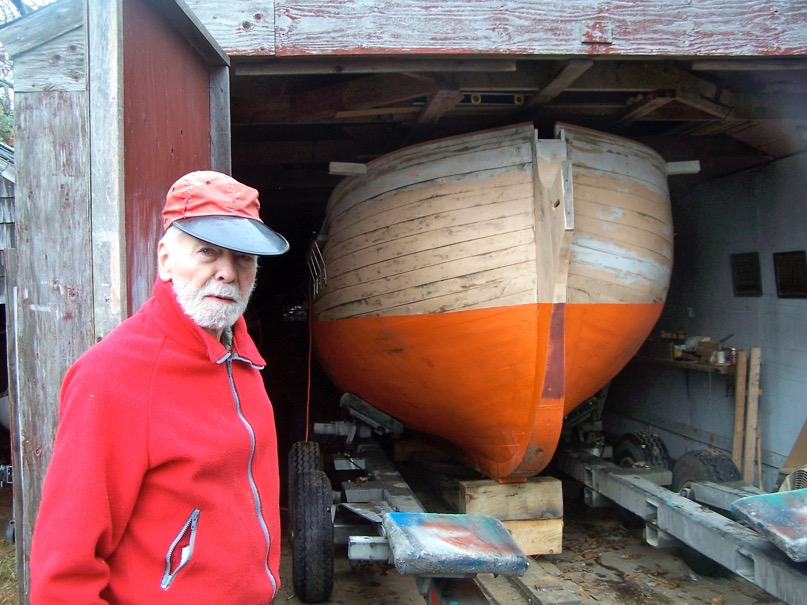
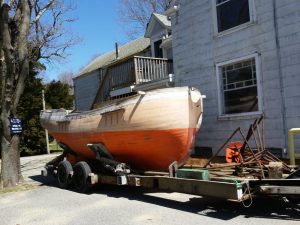








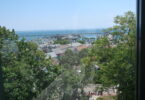





















What a great story! I am so proud of my brother Bernie and his wife Virginia Sweeney of helping this boat come to a place where it will be finished and loved and respected. It is a great tribute to a great and talented man, Fred Littleton.
I met Fred when I had the honor of purchasing his catboat Pandora. It was an enjoyable opportunity to talk to him and discuss his interests in the maritime service especially his time in the US Navy as a officer stationed in the Pacific onboard a LSD. Of course I was able to be in the barn when he was building this boat. I was amazed! He was one of those individuals that enter into one’s life that you never forget.